üĒ(l©ói)į┤Ż║╗ź┬ō(li©ón)ŠW(w©Żng) ū„š▀Ż║äŅ(l©¼)▓ĮėóšZ(y©│) 2016-11-23 10:42:47
ĪĪĪĪYou might think you‘re a stickler for correct pronunciation����Ż¼ but there’s a few tricky words that continue to flummox the best of us��ĪŻ
ĪĪĪĪ─Ń┐╔─▄ęį×ķūį╝║ĘŪ│ŻūóęŌ░l(f©Ī)궥─£╩(zh©│n)┤_Č╚�����Ż¼Ą½╩Ūėą─Ū├┤ÄūéĆ(g©©)╝¼╩ųĄ─å╬į~��Ż¼╝┤╩╣╩Ū╬ęéāųą░l(f©Ī)ę¶ūŅ║├Ą──ŪéĆ(g©©)╚╦┐╔─▄ę▓Ģ■(hu©¼)ūxÕe(cu©░)�ĪŻ
ĪĪĪĪFrom foodstufs such as Quinoa and sorbet to Dengue FeverŻ¼ you won‘t be left red-faced again after taking the test��ĪŻ
ĪĪĪĪÅ─Quinoa(▐╝¹£)�ĪóSorbet(╣¹ųŁ▒∙ĖŌ)Ą╚╩│ŲĘĄĮDengue Fever(ĄŪĖ’¤ßŻ¼ę╗ĘNé„╚Š▓Ī)�����Ż¼─Ńū÷┴╦▀@éĆ(g©©)£y(c©©)įć║¾Ż¼Š═į┘ę▓▓╗Ģ■(hu©¼)ę“?y©żn)ķ▀@ą®į~Č°▒╗ĖŃĄ├├µ╝tČ·│Ó└▓���ĪŻ
ĪĪĪĪAn often abused word is the strong Italian coffee you might drink when you‘re in need of a pick me up����ĪŻ It it Esprexo�����Ż¼ Asspresso��Ż¼ Expresso or Espresso?
ĪĪĪĪę╗éĆ(g©©)Įø(j©®ng)│Ż▒╗ūxÕe(cu©░)Ą─å╬į~Š═╩ŪęŌ┤¾└¹ØŌ┐¦Ę╚(Espresso)����ĪŻį┌─ŃąĶę¬╠ß╔±Ą─Ģr(sh©¬)║“Ż¼─Ń┐╔─▄║╚▀^(gu©░)▀@ĘN┐¦Ę╚���ĪŻ╦³æ¬(y©®ng)įōūxū„Esprexo�����Ż¼Asspresso�����Ż¼Expresso▀Ć╩ŪEspresso─ž?
ĪĪĪĪThe middle class staple quinoa can be a bit of a tongue twister that leaves you grappling over keen-wah��Ż¼ kween-noah�����Ż¼ kween-wah or keen-noah����ĪŻ
ĪĪĪĪųą«a(ch©Żn)ļA╝ē(j©¬)Ą─ų„╩│▐╝¹£(quinoa)Ą─ūxę¶┐╔─▄Š═ėą³c(di©Żn)ā║▐ų┐┌��Ż¼─Ń┐╔─▄Ģ■(hu©¼)╝mĮY(ji©”)╦³įōūxū„keen-wah�����Ż¼kween-noah����Ż¼kween-wah▀Ć╩Ūkeen-noah─ž?
ĪĪĪĪRaspberries are a popular treatŻ¼ but should the ‘p’ be silent?
ĪĪĪĪśõ(sh©┤)▌«│Ż▒╗ė├üĒ(l©ói)šą┤²┐═╚╦����Ż¼Ą½╩Ū▀@éĆ(g©©)å╬į~└’Ą─“p”▓╗░l(f©Ī)ę¶åß?
ĪĪĪĪA quiz sets the record straight by testing your knowledge of commonly mispronounced words - and setting you on the right track�ĪŻ
ĪĪĪĪę╗éĆ(g©©)ąĪ£y(c©©)“×(y©żn)═©▀^(gu©░)£y(c©©)įć─Ńī”(du©¼)─Ūą®│Ż▒╗ūxÕe(cu©░)Ą─į~ģRĄ─┴╦ĮŌüĒ(l©ói)×ķ─Ń╝mš²░l(f©Ī)ę¶�����ĪŻ
ĪĪĪĪš²┤_ūxę¶ę¶Ņl╩ŠĘČ(BY FISH)

ĪĪĪĪ1�ĪŻ ─Ń╚ń║╬ĘQ║¶▒▒śOų▄ć·Ą─▒∙ė“?
ĪĪĪĪAĪŻ Santa’s House(╩źšQ└Ž╚╦ų«╝ę)
ĪĪĪĪB���ĪŻ The Arctic(▒▒śO╚”)
ĪĪĪĪC�����ĪŻ The Artic(═Ž▄ć)
ĪĪĪĪD�����ĪŻ The Atric
ĪĪĪĪThe correct answer is B���Ż¼ pronounced as Ark-tickĪŻ
ĪĪĪĪš²┤_┤░Ė╩ŪB����Ż¼ūxū„“Ark-tick”ĪŻ
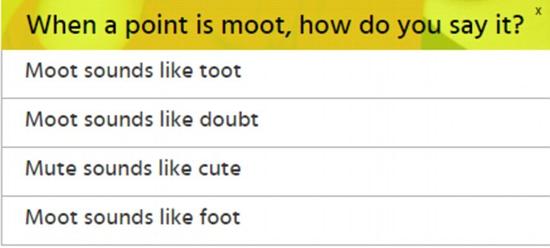
ĪĪĪĪ2����ĪŻ «ö(d©Īng)─│éĆ(g©©)ė^³c(di©Żn)ø](m©”i)╩▓├┤īŹ(sh©¬)ļHęŌ┴x(moot)�����Ż¼─Ńį§├┤šf(shu©Ł)▀@éĆ(g©©)į~(moot)?ĪĪĪĪA�ĪŻ Moot┬Ā(t©®ng)ŲüĒ(l©ói)Ž±toot(ÓĮÓĮ┬Ģ)���ĪŻ
ĪĪĪĪB���ĪŻ Moot┬Ā(t©®ng)ŲüĒ(l©ói)Ž±doubt(æčę╔)ĪŻ
ĪĪĪĪC����ĪŻ Moot┬Ā(t©®ng)ŲüĒ(l©ói)Ž±cute(┐╔É█(©żi)Ą─)��ĪŻ
ĪĪĪĪD���ĪŻ Moot┬Ā(t©®ng)ŲüĒ(l©ói)Ž±foot(─_)��ĪŻ
ĪĪĪĪA moot point should be pronounced to rhyme with toot����Ż¼ the correct answer is AĪŻ
ĪĪĪĪę╗éĆ(g©©)ø](m©”i)╩▓├┤īŹ(sh©¬)ļHęŌ┴xĄ─ė^³c(di©Żn)ųąĄ─“moot”Ą─░l(f©Ī)ę¶┼c“toot”ųCę¶����Ż¼š²┤_┤░Ė×ķAĪŻ
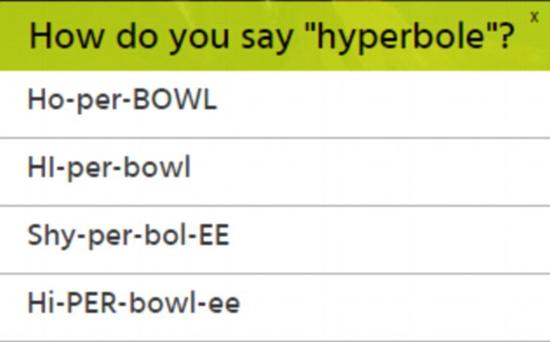
ĪĪĪĪ3��ĪŻ ─Ńį§├┤ūx“hyperbole”(┐õÅłĄ─šZ(y©│)Šõ)?ĪĪĪĪA�����ĪŻ Ho-per-BOWL
ĪĪĪĪB.HI-per-bowl
ĪĪĪĪC��ĪŻ Shy-per-bol-EE
ĪĪĪĪD���ĪŻ Hi-PER-bowl-ee
ĪĪĪĪYou might think the ‘e’ at the end of the word is silent�Ż¼ but in fact it‘s exaggerated meaning the word is pronounced Hi-PER-bowl-ee���ĪŻ
ĪĪĪĪ─Ń┐╔─▄ęį×ķ▀@éĆ(g©©)å╬į~─®╬▓╠ÄĄ─“e”▓╗░l(f©Ī)ę¶�����Ż¼╚╗Č°īŹ(sh©¬)ļH╔Ž��Ż¼▀@éĆ(g©©)å╬į~ųĖĄ─╩Ū“┐õÅłĄ─”����Ż¼ūxū„Hi-PER-bowl-eeĪŻ

ĪĪĪĪ4��ĪŻ ─Ńį§├┤ūx“suite”(╠ūĘ┐)▀@éĆ(g©©)į~?
ĪĪĪĪA����ĪŻ suit(╠ūčb)
ĪĪĪĪBĪŻ sweet(╠Ū╣¹)
ĪĪĪĪC����ĪŻ soot-tay
ĪĪĪĪDĪŻ sweet-tay
ĪĪĪĪIt might look as if it requires some fancy French pronunciation but suite should sounds exactly the same as sweet���ĪŻ
ĪĪĪĪ▀@éĆ(g©©)å╬į~┐┤╔Ž╚ź╦Ų║§ąĶę¬ę╗ą®╗©╔┌Ą─Ę©šZ(y©│)░l(f©Ī)ę¶��Ż¼Ą½╩Ū“suite”▀@éĆ(g©©)į~Ą─ūxę¶ŲõīŹ(sh©¬)Ė·“sweet”ŽÓ═¼�ĪŻ
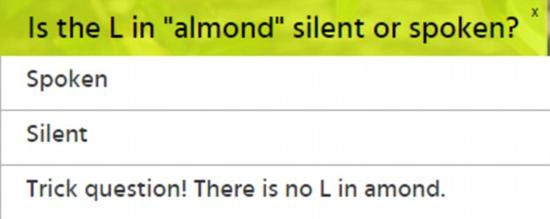
ĪĪĪĪ5�ĪŻ “almond”(ąė╚╩)ųąĄ─“L”░l(f©Ī)▓╗░l(f©Ī)ę¶?
ĪĪĪĪA�����ĪŻ ░l(f©Ī)ę¶
ĪĪĪĪB����ĪŻ ▓╗░l(f©Ī)ę¶
ĪĪĪĪC����ĪŻ▀@╩ŪéĆ(g©©)Ž▌┌Õ!“amond”▀@éĆ(g©©)å╬į~└’éĆ(g©©)Ė∙▒ŠŠ═ø](m©”i)ėą“L”���ĪŻ
ĪĪĪĪThe ‘l’ in almond is silent���Ż¼ meaning it should be pronounced like ah-mondĪŻ
ĪĪĪĪ“almond”ųąĄ─“L”╩Ū▓╗░l(f©Ī)궥─���Ż¼ę▓Š═╩Ūšf(shu©Ł)╦³Ą─░l(f©Ī)ę¶ŅÉ╦Ų“ah-mond”�����ĪŻ
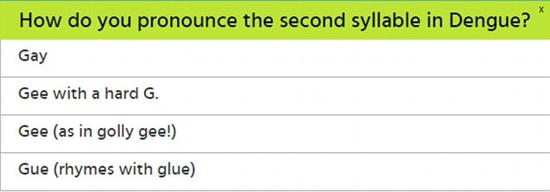
ĪĪĪĪ6�����ĪŻ ─Ńį§├┤ūx“Dengue”▀@éĆ(g©©)į~ųąĄ─Ą┌Č■éĆ(g©©)ę¶╣Ø(ji©”)?
ĪĪĪĪA����ĪŻ Gay(═¼ąįæ┘š▀)
ĪĪĪĪBĪŻ ūxū„“Gee”�����Ż¼ŪęųžūxG���ĪŻ
ĪĪĪĪC���ĪŻ ūxū„Gee(Š═Ž±golly geeųą“gee”Ą─░l(f©Ī)ę¶)
ĪĪĪĪDĪŻūxū„Gue(┼cglueųCę¶)
ĪĪĪĪDengue Fever is a tricky one to say���Ż¼ but the correct pronunciation is den-gee to rhyme�Ż¼ as in ‘gee whizz’�����ĪŻ
ĪĪĪĪĄŪĖ’¤ß(Dengue Fever)▀@éĆ(g©©)į~▓╗╠½║├ūx�Ż¼Ą½╩Ū×ķ┴╦č║ĒŹŻ¼▀@éĆ(g©©)į~æ¬(y©®ng)ūxū„“den-gee”���Ż¼Ė·“gee-whizz”ųąĄ─“gee”░l(f©Ī)궎Ó╦Ų����ĪŻ
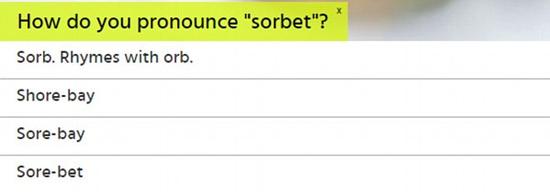
ĪĪĪĪ7����ĪŻ ─Ńį§├┤ūx“sorbet”(╣¹ųŁ▒∙ĖŌ)▀@éĆ(g©©)į~?
ĪĪĪĪAĪŻ Sorb��ĪŻ┼corb���ĪŻųCę¶
ĪĪĪĪB�ĪŻ Shore-bay
ĪĪĪĪC���ĪŻ Sore-bay
ĪĪĪĪD�ĪŻ Sore-bet
ĪĪĪĪThe popular dessert is correctly pronounced as sore-bay�����ĪŻ
ĪĪĪĪ▀@ĘNéõ╩▄ÜgėŁĄ─╠³c(di©Żn)æ¬(y©®ng)ūxū„“sore-bay”���ĪŻ
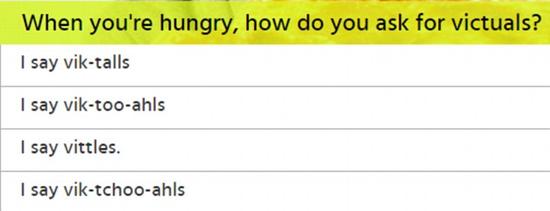
ĪĪĪĪ8����ĪŻ ─ŃI┴╦Ą─Ģr(sh©¬)║“���Ż¼╚ń║╬╦„ę¬╩│╬’(Victuals)?
ĪĪĪĪA����ĪŻ╬ęĢ■(hu©¼)šf(shu©Ł)“vik-talls”ĪŻ
ĪĪĪĪB���ĪŻ╬ęĢ■(hu©¼)šf(shu©Ł)“vik-too-ahls”���ĪŻ
ĪĪĪĪCĪŻ╬ęĢ■(hu©¼)šf(shu©Ł)“vittles”���ĪŻ
ĪĪĪĪD����ĪŻ╬ęĢ■(hu©¼)šf(shu©Ł)“vik-tchoo-ahls”���ĪŻ
ĪĪĪĪThe ‘c’ in the word victuals is silent���Ż¼ so it should come out as ‘vittles’ĪŻ
ĪĪĪĪ“victuals”ųąĄ─“c”▓╗░l(f©Ī)ę¶�Ż¼╦∙ęį▀@éĆ(g©©)å╬į~Ą─░l(f©Ī)ę¶ŅÉ╦Ų“vittles”ĪŻ
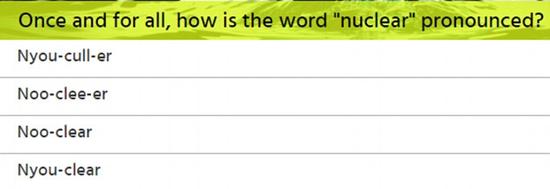
ĪĪĪĪ9�����ĪŻ ūŅ║¾ę╗éĆ(g©©)Ż¼“nuclear”▀@éĆ(g©©)į~į§├┤ūx?
ĪĪĪĪA���ĪŻ Nyou-cull-er
ĪĪĪĪBĪŻ Noo-clee-er
ĪĪĪĪC�����ĪŻ Noo-clear
ĪĪĪĪD����ĪŻ Nyou-clear
ĪĪĪĪIt‘s a word that’s commonly used and confuses manyŻ¼ but the right way to say it is Noo-clee-er�ĪŻ
ĪĪĪĪ▀@éĆ(g©©)å╬į~║▄│Żė├Ż¼Ą½╦³ę▓ūī║▄ČÓ╚╦└¦╗¾▓╗ęč���Ż¼Ųõš²┤_Ą─ūxę¶×ķ“Noo-clee-er”�����ĪŻ
ĪĪĪ�����ĪŻ©▒Š╬─▐D(zhu©Żn)ūį╗ź┬ō(li©ón)ŠW(w©Żng)Ż®
ĪĪĪĪĖ³ČÓėóšZ(y©│)īW(xu©”)┴Ģ(x©¬)┘Yį┤���Ż¼šł(q©½ng)?ji©Īn)Lå¢(w©©n)äŅ(l©¼)▓ĮėóšZ(y©│)╗“╬óą┼ĻP(gu©Īn)ūó“äŅ(l©¼)▓Įć°(gu©«)ļHā║═»Į╠ė²”��ĪŻ
ĪĪĪĪŽÓĻP(gu©Īn)═Ų╦]Ż║
ąĪ╔²│§įćŅ}��ĪóŲ┌ųąŲ┌─®Ņ}����ĪóąĪīW(xu©”)ŖWöĄ(sh©┤)Ņ}
▒Mį┌ŖWöĄ(sh©┤)ŠW(w©Żng)╣½▒Ŗ╠¢(h©żo)

ĪĪĪĪ ÜgėŁ╩╣ė├╩ųÖC(j©®)�ĪóŲĮ░ÕĄ╚ęŲäė(d©░ng)įO(sh©©)éõįLå¢(w©©n)ėūĮ╠ŠW(w©Żng)Ż¼ėūā║Į╠ė²╬ęéāę╗┬Ę┼Ń░ķ═¼ąą�ŻĪ>>³c(di©Żn)ō¶▓ķ┐┤


















